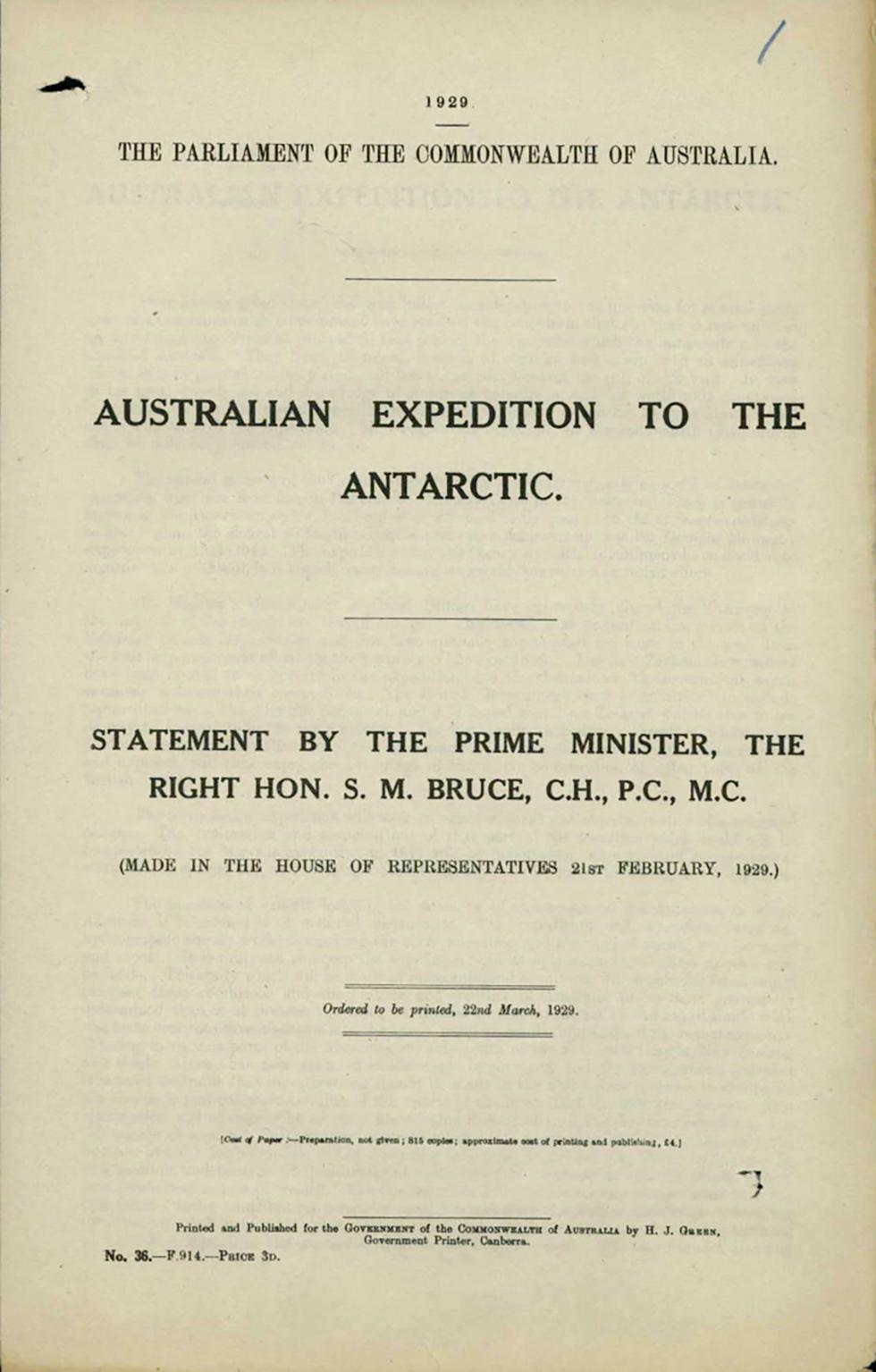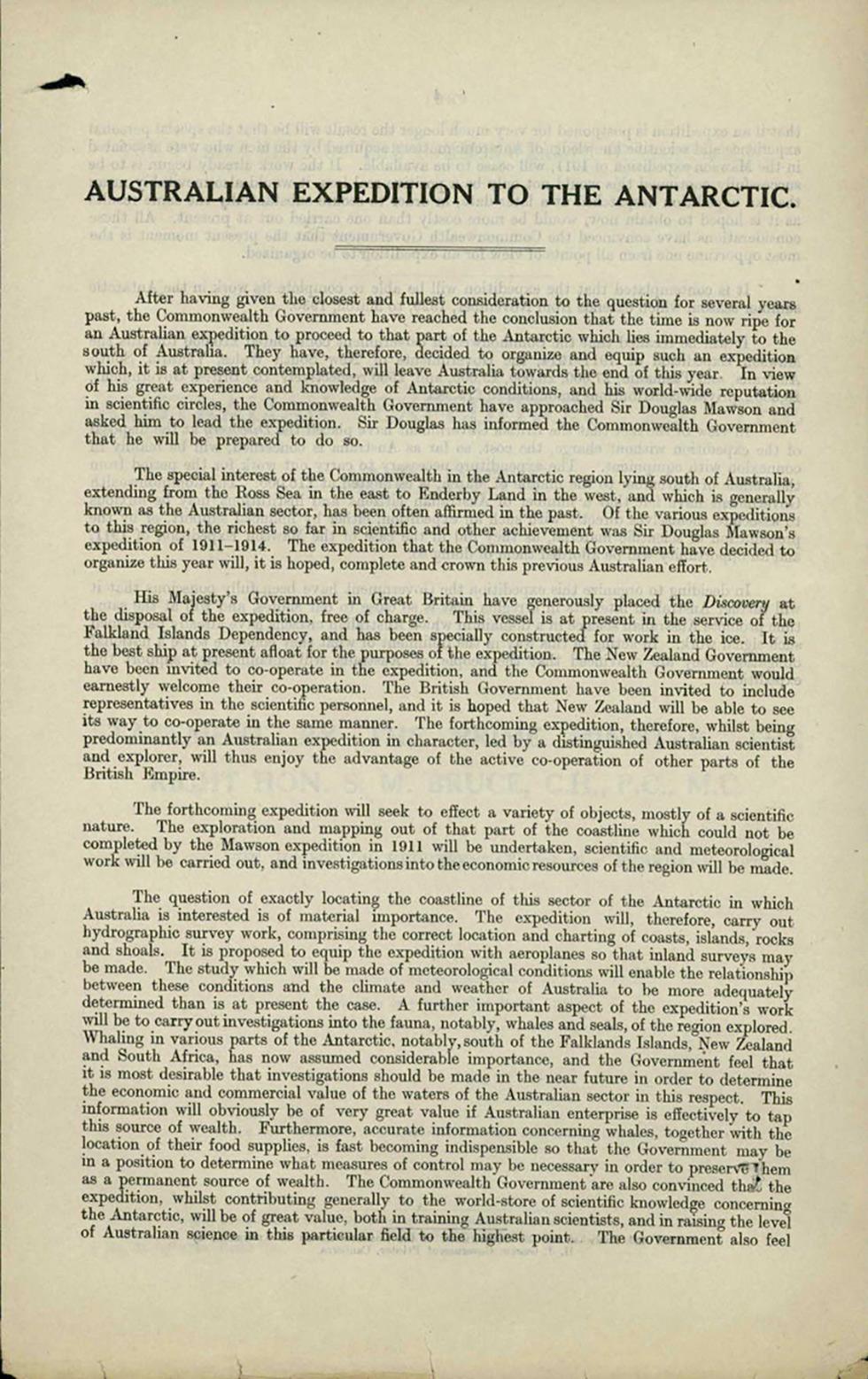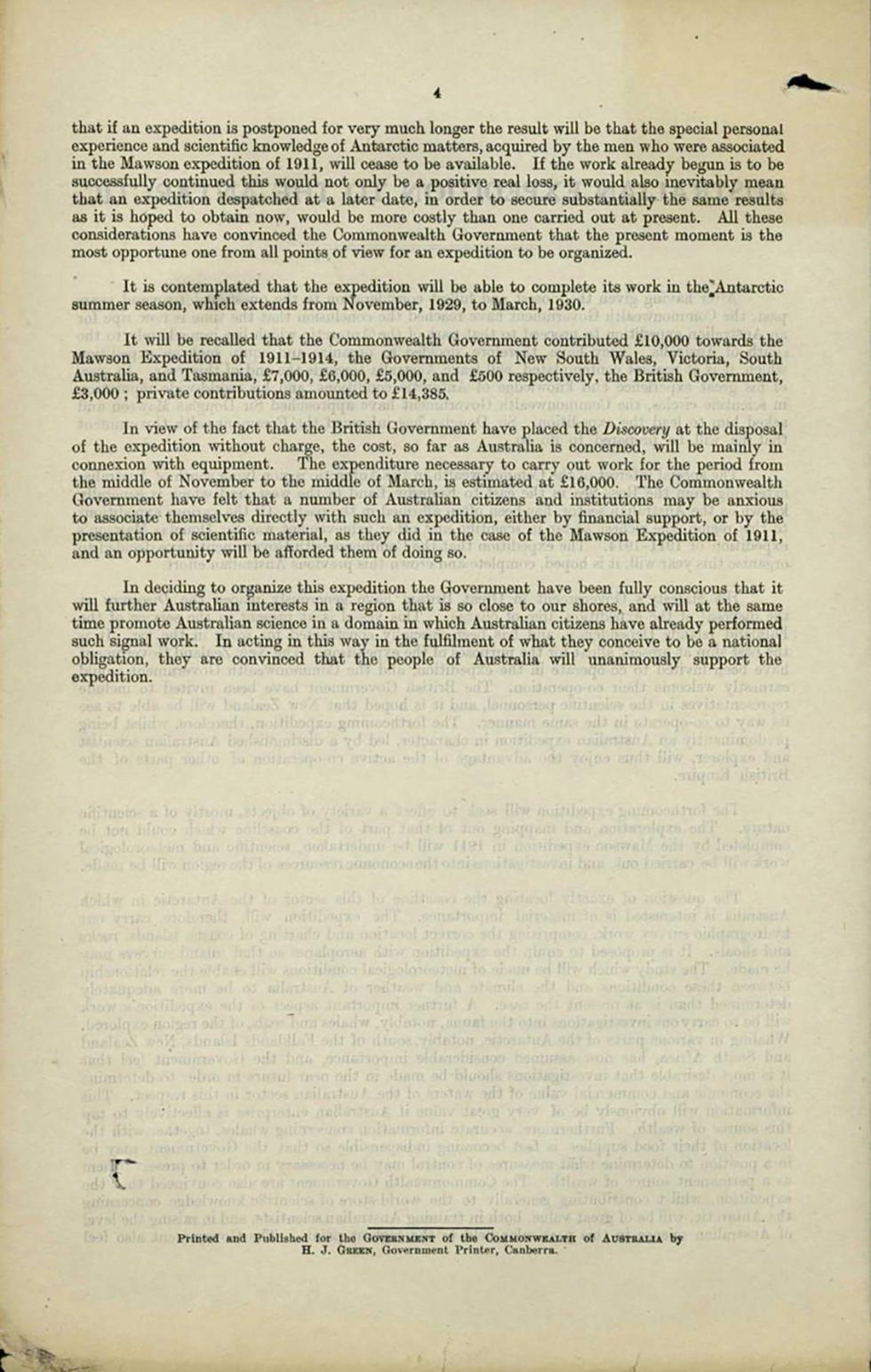
Statement to the Parliament by Prime Minister Bruce - page 1

Statement to the Parliament by Prime Minister Bruce - page 2

Statement to the Parliament by Prime Minister Bruce - page 3
Aboriginal and Torres Strait Islander people should be aware that the National Archives' website and collection contain the names, images and voices of people who have died.
Some records include terms and views that are not appropriate today. They reflect the period in which they were created and are not the views of the National Archives.


Statement to the Parliament by Prime Minister Bruce - page 1

Statement to the Parliament by Prime Minister Bruce - page 2

Statement to the Parliament by Prime Minister Bruce - page 3
[Page 1 – title page.]
1929.
THE PARLIAMENT OF THE COMMONWEALTH OF AUSTRALIA.
[Main heading:] AUSTRALIAN EXPEDITION TO THE ANTARCTIC.
[Subheading:] STATEMENT BY THE PRIME MINISTER, THE RIGHT HON. S. M. BRUCE, C.H., P.C., M.C.
(MADE IN THE HOUSE OF REPRESENTATIVES 21st FEBRUARY, 1929.)
Ordered to be printed, 22nd March 1929.
[Small text:] {Cost of Paper:- Preparation, not given; 815 copies; approximate cost of printing and publishing, £4.}
[Footer:] Printed and Published for the Government of the Commonwealth of Australia by H. J. an Green, Government Printer, Canberra.
No. 36. - F.914. - Price 3D.
[Page 2.]
[Heading:] AUSTRALIAN EXPEDITION TO THE ANTARCTIC.
After having given the closest and fullest consideration to the question for several years past, the Commonwealth Government have reached the conclusion that the time is now ripe for an Australian expedition to proceed to that part of the Antarctic which lies immediately to the south of Australia. They have, therefore, decided to organise and equip such an expedition which, it is at present contemplated, will leave Australia towards the end of this year. In view of his great experience and knowledge of Antarctic conditions, and his world-wide reputation in scientific circles, the Commonwealth Government have approached Sir Douglas Mawson and asked him to lead the expedition. Sir Douglas has informed the Commonwealth Government that he will be prepared to do so.
The special interest of the Commonwealth in the Antarctic region lying south of Australia, extending from the Ross Sea in the east to Enderby Land in the west, and which is generally known as the Australian sector, has been often affirmed in the past. Of the various expeditions to this region, the richest so far in scientific and other achievement was Sir Douglas Mawson’s expedition of 1911-1914. The expedition that the Commonwealth Government have decide to organise this year will, it is hoped, complete and crown this previous Australian effort.
His Majesty's Government in Great Britain have generously placed the Discovery [name of ship in italics] at the disposal of the expedition, free of charge. This vessel is at present in the service of the Falkland Islands Dependency, and has been specially constructed for work in the ice. It is the nest ship at present afloat for the purposes of the expedition. The New Zealand Government have been invited to co-operate in the expedition, and the Commonwealth Government would earnestly welcome their co-operation. The British Government have been invited to include representatives in the scientific personnel, and it is hoped that New Zealand will be able to see its way to co-operate in the same manner. The forthcoming expedition, therefore, whilst being predominantly an Australian expedition in character, led by a distinguished Australian scientist and explorer, will this enjoy the advantage of the active co-operation of other parts of the British Empire.
The forthcoming expedition will seek to effect a variety of objects, mostly of a scientific nature. The exploration and mapping out of that part of the coastline which could not be completed by the Mawson expedition in 1911 will be undertaken, scientific and meteorological work will be carried out, and investigations into the economic resources of the region will be made.
The question of exactly locating the coastline of this sector of the Antarctic in which Australia is interested is of material importance. The expedition will, therefore, carry out hydrographic survey work, comprising the correct location and charting of coasts, islands, rocks and shoals. It is proposed to equip the expedition with aeroplanes so that inland surveys may be made. The study which will be made of meteorological conditions will enable the relationship between these conditions and the climate and weather of Australia to be more adequately determined that is at present the case. A further important aspect of the expedition’s work will be to carry out investigations into the fauna, notably, whales and seals, of the region explored. Whaling in various parts of the Antarctic, notably, south of Falklands Islands, New Zealand and South Africa, has now assumed considerable importance, and the Government feel that it is most desirable that investigations should be made in the near future in order to determine the economic and commercial value of the waters of the Australian sector in this respect. This information will obviously be of very great value if Australian enterprise is effectively to tap this source of wealth. Furthermore, accurate information concerning whales, together with the location of their food supplies, is fast becoming indispensable so that the Government may be in a position to determine what measures of control may be necessary in order to preserve them as a permanent source of wealth. The Commonwealth Government are also convinced that the expedition, whilst contributing generally to the world-store of scientific knowledge concerning the Antarctic, will be of great value, both in training Australian scientists, and in raising the level of Australian science in this particular filed to the highest point. The Government also feel
[Page 3, marked with page number '4'.]
that if an expedition is postponed for very much longer the result will be that the special personal experience and scientific knowledge of Antarctic matters, acquired by the men who were associated in the Mawson expedition of 1911, will cease to be available. If the work already begun is to be successfully continued this would not only be a positive real loss, it would also inevitably mean that an expedition despatched at a later date, in order to secure substantially the same results as it is hoped to obtain now, would be more costly than one carried out at present. All these considerations have convinced the Commonwealth Government that the present moment is the most opportune one from all points of view for an expedition to be organized.
It is contemplated that the expedition will be able to complete its work in the Antarctic summer season, which extends from November, 1929, to March, 1930.
It will be recalled that the Commonwealth Government contributed £10,000 towards the Mawson Expedition of 1911-1914, the Governments of New South Wales, Victoria, South Australia, and Tasmania, £7,000, £6,000, £5,000 and £500 respectively, the British Government, £3,000; private contributions amounted to £14,385.
In view of the fact that the British Government have placed the Discovery [name of ship in italics] at the disposal of the expedition without charge, the cost, so far as Australia is concerned, will be mainly in connexion with equipment. The expenditure necessary to carry out work for the period from the middle of November to the middle of March, is estimated at £16,000. The Commonwealth Government have felt that a number of Australian citizens and institutions may be anxious to associate themselves directly with such an expedition, either by financial support, or by the presentation of scientific material, as they did in the case of the Mawson Expedition of 1911, and an opportunity will be afforded them of doing so.
In deciding to organize this expedition the Government have been fully conscious that it will further Australian interests in a region that is so close to our shores, and will at the same time promote Australian science in a domain in which Australian citizens have already performed such signal work. In acting in this way in the fulfilment of what they conceive to be a national obligation, they are convinced that the people of Australia will unanimously support the expedition.
[Footer:] Printed and Published for the GOVERNMENT of the COMMONWEALTH of AUSTRALIA by H.J. GREEN, Government Printer, Canberra.
This is the statement made to the Australian Parliament on 21 February 1929 by Prime Minister Stanley Melbourne Bruce on a proposed Australian expedition to the Antarctic. The statement outlines details of Australia’s collaboration with Britain and New Zealand to mount this expedition. Prime Minister Bruce also refers to the potential benefits that his government anticipates for Australia from a successful expedition.
Learn how to interpret primary sources, use our collection and more.
